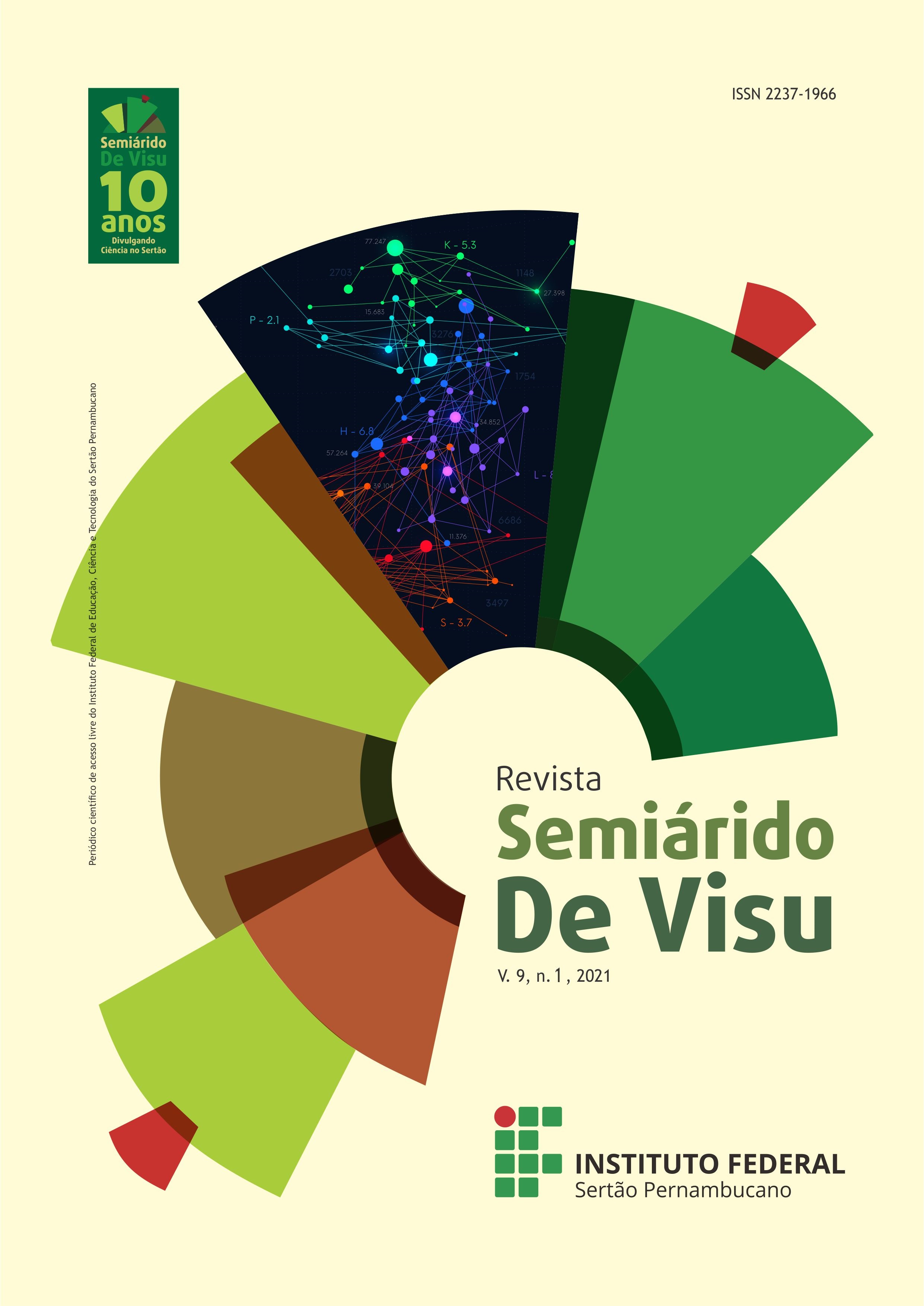A Deep Neural Network Model for SARS-CoV-2 Pandemic Forecasting in Brazil
Visualizações: 610DOI:
https://doi.org/10.31416/rsdv.v9i1.21Keywords:
Deep Neural Networks, Time Series, Prediction, COVID-19Abstract
The World Health Organization has declared coronavirus disease 2019 (COVID-19) as an unparalleled pandemic in a hundred years. The etiological agent of COVID-19 is the new severe acute respiratory syndrome coronavirus 2 (SARS-Cov-2), which has caused complications of different severity in the human respiratory system, and hence, overburdening global health systems due to excessive demand for hospitalizations in intensive care units. In this way, due to the absence of effective drugs and licensed vaccines to wrestle against the COVID-19 and its variants, quarantine measures and social distancing have been employed in an attempt to slow the accelerated spread of COVID-19. However, it caused a break in numerous economic activities. In this scenario, predicting the pandemic’s dynamic is essential to guide the strategy to deal simultaneously with the rise in the demand for health support and effects on the economy. Therefore, this work presents a deep neural network model designed by a gradient-based learning process to predict the spread of COVID-19, using a time series-based approach. In order to assess the model’s prediction performance, we use COVID-19 time series, with daily frequency, in Brazil. Achieved results show effectiveness, in terms of predictive performance, of the proposed model to estimate the COVID-19 pandemic’s dynamics.
References
ARAUJO,R.deA.etal.Adeepincreasing-decreasing-linearneuralnetworkfor?nancialtimeseriesprediction. Neurocomputing,v.347,p.59–81,2019.
AYITTEY, F. K. et al. Economic impacts of wuhan 2019-ncov on china and the world.J Med Virol, v. 5, n. 92, p.473–475, 2020.
BENVENUTO,D.etal.Applicationofthearimamodelonthecovid-2019epidemicdataset.DatainBrief,v.29, p.105340,2020.
BOX, G. E. P.; JENKINS, G. M.; REINSEL,G. C. TimeSeriesAnalysis: ForecastingandControl. Third.New Jersey: PrenticeHall,1994.
CAO, J. et al. Clinical features and short-term outcomes of 18 patients with corona virus disease 2019 in intensivecare unit.Intensive Care Medicine, In Press, 2020.
CHENG-I, W. et al. Sars-cov-2, covid-19 and inherited arrhythmia syndromes.Heart Rhythm, In Press, 2020.
CLEMENTS, M. P.; HENDRY, D. F. On the limitations of comparingmean square forecasterrors. Journalof Forecasting,v.12,n.8,p.617–637,1993.
DINIZ, N.; LIMA, F. G.; FILHO, A. C. da S. The impact of the hurst window in the financial time series forecast:an analysis through the exchange rate.Review of Business Research, v. 12, p. 27–33, 2012.
DOZAT,T.Incorporatingnesterovmomentumintoadam.In: .[S.l.: s.n.],2016.
DUCHI, J. C.; HAZAN, E.; SINGER, Y. Adaptive subgradient methods for online learning and stochastic optimization.J.Mach.Learn.Res.,v.12,p.2121–2159,2011.
FRASER, A.; SWINNEY, H. Independentcoordinatesfor strangeatractorsfrom mutual information.Physical ReviewA,v.33,n.2,p.1134–1140,1986.
GAO,G.F.From“a”to“z”: attacksfromemergingandre-emergingpathogens.Cell,v.172,p.1157–1159,2018.
HANN, T. H.; STEURER, E. Much ado aboutnothing? exchangerate forecasting: Neural networksvs. linear modelsusingmonthlyandweeklydata.Neurocomputing,v.10,p.323–339,1996.
HE,F.;DENG,Y.;LI,W.Coronavirusdisease2019(covid-19): Whatweknow? Journalofmedicalvirology,In Press,2020.
HURST, E. Longtermstoragecapacityof reservoirs.TransactionsoftheAmericanSocietyofCivilEngenieers, v.116,p.770–799,1951.
IMAI,N.etal.Report1:Estimatingthepotentialtotalnumberofnovelcoronavirus(2019-ncov)casesinwuhancity. https://www.imperial.ac.uk/mrc-global-infectious-disease-analysis/covid-19/report-1-case-estimates-of-covid-19/, 2020.
IOFFE,S.;SZEGEDY,C.Batchnormalization: acceleratingdeepnetworktrainingbyreducinginternalcovariate shift.InternationalConferenceonInternationalConferenceonMachineLearning,v.37,p.448–456,2015.
KINGMA, D. P.; BA, J.Adam: A Method for Stochastic Optimization. 2014.
LAI, C. et al. Severe acute respiratory syndrome coronavirus 2 (sars-cov-2) and coronavirus disease-2019 (covid-19): Theepidemicandthechallenges.InternationalJournalofAntimicrobialAgents,InPress,2020.
LAZZERINI,M.; PUTOTO, G. Covid-19 in italy: momentousdecisions and many uncertainties.LancetGlob Health,InPress,2020. LI,L.etal.Propagationanalysisandpredictionofthecovid-19.InfectiousDiseaseModelling,v.5,p.282–292, 2020.
MENEZES,J. M. P.; BARRETO, G. A. Long-termtimeseries predictionwith thenarx network: An empirical evaluation.Neurocomputing,v.71,n.16-18,p.3335–3343,2008.
MUNSTER, V. J. et al. A novelcoronavirusemergingin china- key questionsfor impactassessment. TheNew Englandjournalofmedicine,InPress,2020.
NAIR, V.; HINTON, G. E. Rectified linear units improve restricted boltzmann machines.ICML, p. 807–814, 2010.
PARMET, W. E.; SINHA, M. S. Covid-19 - the law and limits of quarantine.N Engl J Med, v. 382, p. 1–28, 2020.
PENG, L. et al.Epidemic analysis of COVID-19 in China by dynamical modeling. 2020.
PETROPOULOS, F.; MAKRIDAKIS, S. Forecasting the novel coronaviruscovid-19.PLOS ONE, v. 15, n. 3, p.1–8,032020.
PRECHELT,L.Proben1: AsetofNeuralNetworkBenchmarkProblemsandBenchmarkingRules.[S.l.],1994.
REDDI,S.J.;KALE,S.;KUMAR,S.OntheConvergenceofAdamandBeyond.2019.
RODA, W. C. et al. Why is it difficult to accurately predict the covid-19 epidemic?Infectious Disease Modelling,v. 5, p. 271 – 281, 2020.
ROSA, S. G. V.; SANTOS, W. C. Clinical trials on drug repositioning for covid-19 treatment. Pan American JournalofPublicHealth,InPress,2020.
SHE,J.etal.2019novelcoronavirusofpneumoniainwuhan,china: emergingattackandmanagementstrategies. ClinTranslMed,v.9,n.1,p.1–19,2020.
SHEN, M. et al. Modelling the epidemictrend of the 2019 novel coronavirusoutbreak in china.bioRxiv, Cold SpringHarborLaboratory,2020.
SOHRABI,C.etal.Worldhealthorganizationdeclaresglobalemergency: Areviewofthe2019novelcoronavirus (covid-19).InternationalJournalofSurgery,v.76,p.71–76,2020.
SRIVASTAVA, N. et al. Dropout: a simple way to prevent neural networks from overfitting.Journal of MachineLearning Research, v. 15, n. 1, p. 1929–1958, 2014.
STOJANOVIC, M. B. et al. Amethodologyfor trainingset instanceselection using mutualinformationin time seriesprediction.Neurocomputing,v.141,p.236–245,2014.
SUTSKEVER, I. et al. On theimportanceof initialization andmomentumin deep learning.In: Proceedingsof the 30th InternationalConferenceon MachineLearning. Atlanta, Georgia, USA: [s.n.], 2013. (Proceedingsof MachineLearningResearch,3),p.1139–1147.
TANG,B.etal.Anupdatedestimationoftheriskoftransmissionofthenovelcoronavirus(2019-ncov).InfectDis Model,v.5,p.248–255,2020.
TANG, B. et al. Estimation of the transmission risk of the 2019-ncov and its implication for public health interventions.JournalofClinicalMedicine,InPress,2020.
TIELEMAN, T.; HINTON, G. Lecture 6.5 - RmsProp: Divide the gradient by a runningaverageof its recent magnitude.2012.COURSERA:NeuralNetworksforMachineLearning.
VAISHYA, R. et al. Arti?cial intelligence (ai) applications for covid-19 pandemic. Diabetes & Metabolic Syndrome: ClinicalResearch&Reviews,v.14,n.4,p.337–339,2020.
WHO.Coronavirus disease 2019 (COVID-19): Situation Report - 51. [S.l.], 2020.
WU, C. et al. Sars-cov-2, covid-19 and inherited arrhythmia syndromes.Heart rhythm, In Press, 2020.
WU, J. T.; LEUNG, K.; LEUNG, G. M. Nowcasting and forecasting the potential domestic and internationalspread of the 2019-ncov outbreak originating in wuhan, china: a modelling study.The Lancet, v. 395, n. 10225, p.689–697, 2020.
WU, Z.; MCGOOGAN, J. M. Characteristics of and important lessons from the coronavirus disease 2019(covid-19) outbreak in china: Summary of a report of cases from the chinese center for disease control andprevention.JAMA, v. 323, n. 13, p. 1239–1242, 2020.
YOU, C. et al. Estimation of the time-varying reproduction number of covid-19 outbreak in china.medRxiv, ColdSpring Harbor Laboratory Press, 2020.
ZEILER, M. D.ADADELTA: An Adaptive Learning Rate Method. 2012.
ZHAO,S.etal.Estimatingtheunreportednumberofnovelcoronavirus(2019-ncov)casesinchinainthe?rsthalf ofjanuary2020: Adata-drivenmodellinganalysisoftheearlyoutbreak.J.Clin.Med,InPress,2020.
ZHOU,P.etal.Discoveryofanovelcoronavirusassociated with therecentpneumoniaoutbreakin humansand itspotentialbatorigin.bioRxiv,InPress,2020.
ZHU,N. etal. Anovelcoronavirusfrompatientswith pneumoniain china, 2019.NEnglJMed, v.382, n. 2, p. 727–733,2020.















